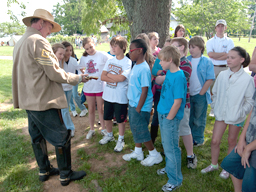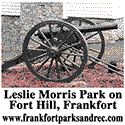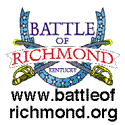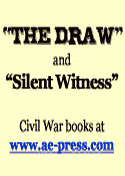|
BORA-Graves Civil War experience
attracts record 720 students
Nine years ago, some 100 students, mostly from Madison County schools, attended the initial Civil War Living History program sponsored by the Battle of Richmond Association (BORA).
The Association’s leadership hoped the event would provide elementary school students with first-hand exposure to Civil War history in general and the Aug. 29-30, 1862 Battle of Richmond in particular. It would be a learning experience about a conflict that turned out to be the one of the most overwhelming Confederate victories of the entire war and the second largest Civil War battle in Kentucky.
Since then, thanks to middle school teacher Sharon Graves, the Living History experience for fourth- and fifth-grade students has become a two-day event, attracted students from schools in six counties, and, this year, was attended on May 13-14 by a record 720 students. The turnout makes it one of the most student attended Living History attractions in the state.
Those attending toured 18 stations of Civil War activities and demonstrations at Battlefield Park that focused on such topics as period clothing and flags, stories about War-Between-the-States personalities, cooking, infantry drilling, agriculture and battlefield officers and commanders.
Some 25 home-school students were among attendees and some schools that were late in registering could not be accommodated. But Mrs. Graves, who teaches eighth grade social studies at Clark-Moores Middle School, plans to expand the event so all those interested can attend.
“I’m hoping to have at least 25 stations next spring so more students can be accommodated,” she said. Such an expansion would keep school groups moving and advert possible backlogs.
Graves, who has coordinated the event for the past eight years, has designed it to complement the social studies curriculum concerning Kentucky history. She is assisted by some 30-40 students from her classes who help plan and coordinate the activity and who voluntarily spend a Saturday learning about the stations, what type of questions may be asked, and what each presenter will be providing. The students are so well trained they also become guides and teachers themselves, and this year, several served as presenters. They are attired in period clothing, dresses for the girls and shirts for the boys, that they help to make.
Many of Sharon’s former students return each year to help with Civil War events at the park and some have become re-enactors themselves. By assisting with other BORA Civil War activities, her current students earn 20 hours of community service credit. In addition, they prepare a research paper on a Civil War topic of their choice and prepare a classroom technical presentation to teach their classmates, utilizing such things as power point, videotape, digital storytelling and websites.
The Civil War program has become a year-long activity in Graves’ class with research topics focusing on a person, activity or event. Students have chosen more than 80 different projects for research including such topics as slavery, medicine, weaponry and causes of the Civil War.
The ripple effect of Sharon’s Civil War efforts has resulted in other Central Kentucky schools emphasizing Civil War curriculum and her teaching techniques.
One teacher who brought students to a recent Living History program pointed out when she was a student she was bored with history because memorizing dates of events seemed to be the whole basis for learning. And the Civil War was just “another link in an endless chain of memorization.”
“But Sharon’s Living History emphasis makes the Civil War come alive,” she said. “It puts history in a learning perspective that’s fun and interesting.”
But, perhaps the greatest compliment to Graves came in 2007 when excessive gasoline prices prevented many rural schools from having field trips. After conferring with school officials and hearing the pleas of their children, parents personally paid for the buses and other expenses so their youngsters could have “the Sharon Graves and BORA Civil War experience.”
|










